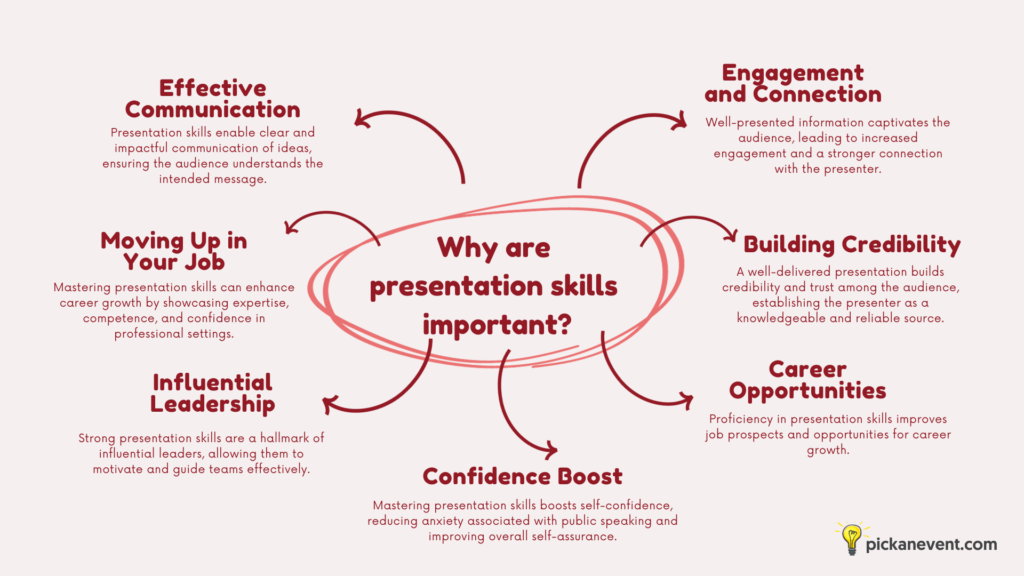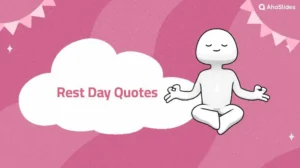Have you ever listened to someone speak and felt completely inspired by their words?
Or have you found it hard to keep people interested when you present?
Mastering presentation skills is like opening a superpower that can elevate your influence, convey your message effectively, and leave a lasting impression.
In this blog post, we’ll explore what presentation skills are, their significance in various aspects of life, and 18 practical steps to enhance your ability to engage and inspire.
Table Of Contents
- What Are Presentation Skills?
- The Importance Of Presentation Skills
- 18 Tips To Improve Your Presentation Skills
- Key Takeaways
- FAQs
What Are Presentation Skills?
Presentation skills refer to the abilities and techniques you use to effectively communicate and convey information to your audience.
These skills include how you talk (using words and how you say them), how you move your body, how you organize your content, how you show visual aids (like pictures or charts), and how you make sure people stay interested and pay attention.
Examples of presentation skills:
Here are simple examples of presentation skills for different scenarios:
- Pitching a new business idea
- Giving a farewell speech
- Giving a one-on-one coaching session
- Giving a project report
- Giving a birthday toast

The Importance Of Presentation Skills
The significance of presentation skills cannot be overstated in today’s world. These skills are vital for effective communication and play a crucial role in various aspects of personal and professional life. Here’s a breakdown of why presentation skills are essential:
- Effective Communication: Presentation skills enable clear and impactful communication of ideas, ensuring the audience understands the intended message.
- Moving Up in Your Job: Mastering presentation skills can enhance career growth by showcasing expertise, competence, and confidence in professional settings.
- Influential Leadership: Strong presentation skills are a hallmark of influential leaders, allowing them to motivate and guide teams effectively.
- Engagement and Connection: Well-presented information captivates the audience, leading to increased engagement and a stronger connection with the presenter in event management.
- Building Credibility: A well-delivered presentation builds credibility and trust among the audience, establishing the presenter as a knowledgeable and reliable source.
- Career Opportunities: Job roles often require presenting ideas, projects, or proposals. Proficiency in presentation skills improves job prospects and opportunities for career growth.
- Confidence Boost: Mastering presentation skills boosts self-confidence, reducing anxiety associated with public speaking at every special event and improving overall self-assurance.

18 Tips To Improve Your Presentation Skills
How do you improve your presentation skills? Improving your presentation skills is a valuable investment that can enhance your communication abilities and boost your confidence. Here are 18 tips on how to make effective presentations:
#1 – Understand Your Audience:
Tailor your presentation to the needs, preferences, and knowledge level of your specific audience to keep them engaged and interested.
- For example, If you’re presenting a financial report to a group of investors, you’ll focus on data, projections, and financial indicators that matter most to them. However, if your audience comprises employees from various departments, you might emphasize how the financial results impact the company’s goals and their specific roles.
#2 – Know Your Material:
Be thoroughly familiar with your topic to speak confidently, answer questions, and handle unexpected situations.
- Imagine you’re giving a presentation on climate change. Being well-versed in the latest scientific research, global statistics, and potential solutions allows you to confidently address questions about the impacts of greenhouse gases and the importance of sustainable practices.
#3 – Storyboard Your Presentation:
Create a visual storyboard or outline to organize your content and ensure a logical flow of information.
#4 – Work on Your Voice:
Experiment with different tones, volumes, and pacing to find a vocal style that is engaging and resonates well with your audience.
If you’re presenting to a group of children about marine life, you’d experiment with a friendly and animated tone to keep them engaged. For a boardroom presentation on a serious topic like company restructuring, you’d adjust your tone to convey authority and professionalism.
#5 – Work on Body Language:
Use positive and confident body language, including gestures, facial expressions, and posture, to reinforce your message and connect with your audience.
#6 – Record and Review Yourself:
Record your practice sessions and review them critically to identify areas for improvement in your delivery and body language.
#7 – Simplify Your Slides:
Use clean and uncluttered visuals with limited text to support your narrative and keep your audience focused. Besides, improving your time management skills while presenting can help you avoid going off-topic and deliver a persuasive presentation.
#8 – Use Engaging Stories and Anecdotes:
Incorporate relatable stories or personal anecdotes to illustrate your points and capture the audience’s attention.
- For example, to emphasize the importance of teamwork in a corporate setting, you might share a personal anecdote about a project where collaboration led to success. Describe a time when a diverse team came together, shared their expertise, and achieved a common goal.
#9 – Encourage Interaction:
Include questions, polls, or discussion points to involve your audience and make the presentation more interactive.
- For example, you can integrate AhaSlides features to gather instant responses on key topics, conduct live polls to assess opinions or establish discussion boards for collaborative audience input. Moreover, features like the spinner wheel and word cloud offered by AhaSlides can be employed for icebreaking activities, further boosting engagement and participation throughout the presentation.
#10 – Control Nervousness:
Practice relaxation techniques, controlled breathing, and positive visualization to manage nervousness and maintain composure during your presentation.

Related:
- Tips to Overcome Fear of Public Speaking
#11 – Rehearse with Different Audiences:
Practice in front of diverse groups to adapt your presentation style and understand the varying needs and reactions of different audiences.
#12 – Learn to Handle Q&A:
Prepare for potential questions and practice concise and effective responses to ensure you address inquiries confidently and accurately.
#13 – Utilize Vocal Pauses:
The strategic pauses emphasize the need for reflection and motivation, giving the audience time to absorb the message and creating a natural, engaging rhythm in the speech.
#14 – Join a Public Speaking Group:
Participate in a public speaking club or workshop to receive regular feedback, share experiences, and improve your skills in a supportive environment.
#15 – Seek Constructive Feedback:
Request honest feedback from peers, mentors, or audience members to gain valuable insights and identify areas for improvement.
#16 – Analyze Great Speakers:
Watch and analyze skilled presenters to learn from their delivery style, storytelling techniques, and engagement strategies.
#17 – Visualize Success:
Visualize yourself delivering a successful presentation, feeling confident and poised, to boost your self-assurance and mental readiness.
#18 – Stay Calm and Present in the Moment:
Focus on the present, breathe, and maintain composure. Embrace any nervous energy and channel it into enthusiasm and passion for your topic.
Key Takeaways
Mastering presentation skills is like having a superpower in our communication toolkit. By being clear, engaging, and well-prepared, we can captivate our audience and convey our message effectively in all types of events. So, let’s practice, learn, and embrace these skills to shine in every presentation we make!
More tips and advice about events? Pick an event that you’re concerned with, and we’ll help you!
FAQs
What are the good presentation skills?
Good Presentation Skills: Clarity in conveying ideas, engaging the audience, organized structure, confident delivery, and effective use of visuals.
What are the 4 types of presentation skills?
4 Types of Presentation Skills: Verbal communication, non-verbal communication, effective use of visuals, and audience engagement techniques.
What are the 5 steps of presentation skills?
5 Steps of Presentation Skills: Planning and organizing, knowing your audience, mastering your content, practicing, and using effective delivery techniques.





